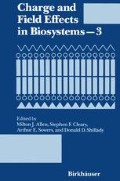Abstract
An increased understanding of receptor mediated processes of species specific pathogens can be obtained by creating novel animal models which possess distinctive features that differ fundamentally from those biological properties displayed naturally by the unaltered animal species. For example, the pathogenesis of certain infectious diseases of importance to human and veterinary medicine is initiated by the binding of the etiological agents directly to host or tissue specific microbial receptors located on cell surfaces. Therefore, biologically relevant animal models for these particular infectious diseases could theoretically be established by transferring cells that contain the appropriate microbial attachment receptors to selected tissues of common laboratory animals. The histologically modified animals should now become susceptible to infection by those host and tissue restricted microbial pathogens to which the unaltered animals are naturally resistant.
Access this chapter
Tax calculation will be finalised at checkout
Purchases are for personal use only
Preview
Unable to display preview. Download preview PDF.
References
Arko RJ (1989): Animal models for pathogenic Neisseria species. Clin. Microbiol Rev. 2(Suppl):S56-S59.
Bates GW, Saunders JA, and Sowers AE (1987): Principles and applications of electrofusion. In Cell Fusion A. E. Sowers ed. Plenum Press, New York pp.367–395.
Blackwell JM, Ezekowitz RA, Roberts MB, Channon JY, Sim RB, and Gordon S (1985): Macrophage complement and lectin-like receptors bind Leishmania in the absence of serum. J. Exp. Med. 162:324–331.
Cooper MD, McGee ZA, Mulks MH, Koomey JM and Hindman TL (1984): Attachment to and invasion of human fallopian tube mucosa by an IgA1 protease deficient mutant of N. gonorrhoeae and wild type parent. J. Infect. Dis. 150:737–744.
Dalgleish AG, Beverley PCL, Clapham PR, Crawford DH, Greaves MF and Weiss RA (1984): The CD4 (T4) antigen is an essential component of the receptor for the AIDS retrovirus. Nature 312:763–767.
Easmon CSF and Ison CA (1987): N. gonorrhoeae: a versatile pathogen. J. ain. Pathol. 40:1088–1097.
Finaz C, Lefevre A and Teissie J (1984): A new, highly efficient technique for generating somatic cell hybrids. Exp. Cell Res. 150:477–482.
Finlay BB and Falkow S (1988): Comparison of the invasion strategies used by Salmonella cholera-suis. Shigella flexneri and Yersinia enterocolitica to enter cultured animal cells: endosome acidification is not required for bacterial invasion or intracellular replication. Biochimie 70:1089–1099.
Foung SKH and Perkins S (1989): Electric field-induced cell fusion and human monoclonal antibodies. J. Immunolog. Meth. 116:117–122.
Glassy M (1988): Creating hybridomas by electrofusion. Nature 333:579–580.
Grasso RJ, Heller R, Cooley JC and Haller EM (1989): Electrofusion of individual animal cells directly to intact corneal epithelial tissue. Biochim. Biophys. Acta. 980:9–14.
Heller R and Grasso RJ (1990): Transfer of human membrane surface components by incorporating human cells into intact animal tissue by cell-tissue electrofiision in vivo. Biochim. Biophys. Acta. 1024:185–188.
Hewish DR and Werkmeister JA (1989): The use of an electroporation apparatus for the production of murine hybridomas. J. Imunolog. Meth 120:285–289.
Hill JH (1944): Experimental infections with N. gonorrhoeae, II. Animal innoculations. Amer. J. Syph. Gon. Vener. Dis. 28:471–510.
Klatzmann D, Champagne E, Chimaret S, Gniest J, Guetard D, Hercend T, Gluckman J -C and Montagnier L (1984): T-Lymphocytes T4 molecule behaves as the receptor for human retrovirus LAV. Nature 312:767–768.
Kraus SJ (1977): Laboratory Models for N. gonorrhoeae infection. In The Gonococcus. R. B. Roberts, ed. John Wileys and Sons, New York pp. 415–431.
Lo MMS, Tsong TY, Conrad MK, Strittmatter SM, Hester LD and Snyder SH (1984): Monoclonal antibody production by receptor-mediated electrically induced cell fusion. Nature 310:792–794.
Mardh PA, Baldetorp B, Hakansson CH, Fritz H and Westrom L (1979): Studies of ciliated epithelia of the human genital tract. 3. Mucociliary wave activity in organ cultures of human fallopian tubes challenged with N. gonorrhoeae and gonococcal endotoxin. Br. J. Vener. Dis. 55:256–264.
McGee ZA, Johnson AP and Taylor-Robinson D (1981): Pathogenic mechanisms of N. gonorrhoeae: observations on damage to human fallopian tubes in organ culture by gonococci of colony type 1 or type 4. J. Infect. Dis. 143:413–422.
Nemerow GR, Slaw MFE, Cooper NR (1986): Purification of the Epstein-Barr virus/C3d complement receptor of human B lymphocytes by monoclonal antibody affinity chromatography, and assessment of its functional capacities. J. Immunol. Methods 58:709–712.
Payne NR and Horwitz MA (1987): Phagocytoses of Legionella pneumophila is mediated by human monocyte complement receptors. J. Exp. Med. 166:1377–1389.
Sowers AE (1989): Evidence that electrofusion yield is controlled by biologically relevant membrane factors. Biochim. Biophys. Acta. 985(3):334–338.
Sukharev SI, Bandrina IN, Barbul AI, Fedorova LI, Abidor IG, and Zelenin AV (1990): Electrofusion of fibroblasts on the porous membrane. Biochim Biophys Acta 1034:125–131.
Zimmermann U (1986): Electrical breakdown, electropermeabilization and electrofusion. Rev. Physiol. Pharmacol. 105:176–256.
Author information
Authors and Affiliations
Editor information
Editors and Affiliations
Rights and permissions
Copyright information
© 1992 Birkhäuser Boston
About this chapter
Cite this chapter
Heller, R., Gilbert, R. (1992). Model System for the Study of Gonorrhea Created by Cell-Tissue Electrofusion. In: Allen, M.J., Cleary, S.F., Sowers, A.E., Shillady, D.D. (eds) Charge and Field Effects in Biosystems—3. Birkhäuser Boston. https://doi.org/10.1007/978-1-4615-9837-4_33
Download citation
DOI: https://doi.org/10.1007/978-1-4615-9837-4_33
Publisher Name: Birkhäuser Boston
Print ISBN: 978-1-4615-9839-8
Online ISBN: 978-1-4615-9837-4
eBook Packages: Springer Book Archive

